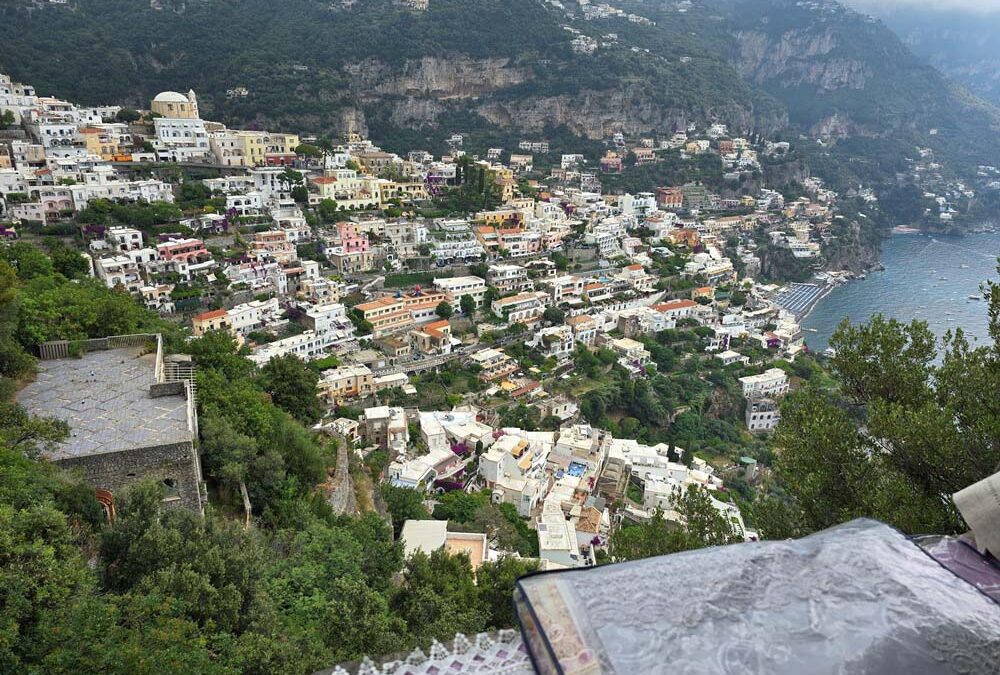By Jeffrey A. Rendall; Photos of Naples, the Amalfi Coast, Sorrento and Pompeii by Jeff and Shari Rendall
NAPLES, Italy — Devastation was everywhere.
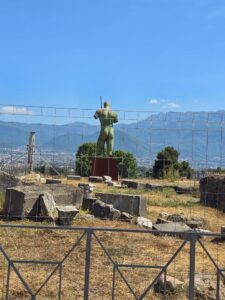 No, this isn’t the description of a scene from a modern-day war or the result of a contemporary natural disaster that impacts entire regions and marks a historic point that will be talked about for years – or centuries, or Millenia. Photos from the early days after World War II ended depict the levelling of all things man-made or natural for miles and miles and miles.
No, this isn’t the description of a scene from a modern-day war or the result of a contemporary natural disaster that impacts entire regions and marks a historic point that will be talked about for years – or centuries, or Millenia. Photos from the early days after World War II ended depict the levelling of all things man-made or natural for miles and miles and miles.
If it’s said Rome wasn’t built in a day, it could almost be offered that Pompeii (near Naples in southwestern Italy, the second stop on our flash journey around the Mediterranean Sea) was practically destroyed in a two-day sequence. More modern examples of such singular and near instantaneous desolation include Hiroshima and Nagasaki in World War II – or the World Trade Center complex on 9/11 — but the forces that hit the ancient Italian city on the coast were supplied by nature rather than atomic bombs, hijacked jetliners, incinerator ordnance or tank shells.
The fact there’s anything remaining from what transpired there is remarkable – a gift to people in our times, but Pompeii is an example of what can happen at the virtual blink of an eye. Sobering. Sad? Sure, but the tragedy happened a few years after the fall of the Temple in Jerusalem in 70 C.E. (C.E. means Common Era and is approximately the same as A.D.). and around the timeframe the Romans captured Masada in 73 C.E..
Make it easy on yourself and say it happened approximately 2000 years ago and you wouldn’t be off by more than a rounding point. At any rate, Pompeii was wrecked by nature about when Christ was crucified (a few decades after, actually, but still within the lifetimes of some of the people of the time). A long, long, time ago. Nearly all historic sites of that era are significantly altered by events and weather, human interaction and historic evolution. Not Pompeii – at least in terms of preservation of its cultural and physical record.
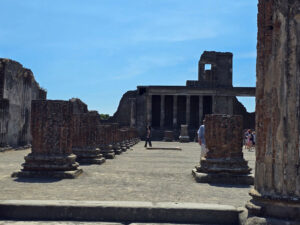 Pompeii, from Wikipedia: “Largely preserved under the ash, Pompeii offers a unique snapshot of Roman life, frozen at the moment it was buried, as well as insight into ancient urban planning. It was a wealthy town of 10,000 to 20,000 residents at the time it was destroyed. It hosted many fine public buildings and luxurious private houses with lavish decorations, furnishings and artworks, which were the main attractions for early excavators; subsequent excavations have found hundreds of private homes and businesses reflecting various architectural styles and social classes, as well as numerous public buildings. Organic remains, including wooden objects and human bodies, were interred in the ash; their eventual decay allowed archaeologists to create moulds of figures in their final moments of life. The numerous graffiti carved on outside walls and inside rooms provide a wealth of examples of the largely lost Vulgar Latin spoken colloquially at the time, contrasting with the formal language of classical writers.
Pompeii, from Wikipedia: “Largely preserved under the ash, Pompeii offers a unique snapshot of Roman life, frozen at the moment it was buried, as well as insight into ancient urban planning. It was a wealthy town of 10,000 to 20,000 residents at the time it was destroyed. It hosted many fine public buildings and luxurious private houses with lavish decorations, furnishings and artworks, which were the main attractions for early excavators; subsequent excavations have found hundreds of private homes and businesses reflecting various architectural styles and social classes, as well as numerous public buildings. Organic remains, including wooden objects and human bodies, were interred in the ash; their eventual decay allowed archaeologists to create moulds of figures in their final moments of life. The numerous graffiti carved on outside walls and inside rooms provide a wealth of examples of the largely lost Vulgar Latin spoken colloquially at the time, contrasting with the formal language of classical writers.
 “Following its destruction, Pompeii remained largely undisturbed until its rediscovery in the late 16th century. Major excavations did not begin until the mid-18th century, which marked the emergence of modern archeology; initial efforts to unearth the city were haphazard or marred by looting, resulting in many items or sites being damaged or destroyed. By 1960, most of Pompeii had been uncovered but left in decay; further major excavations were banned or limited to targeted, prioritised areas. Since 2018, these efforts have led to new discoveries in some previously unexplored areas of the city, including a banquet hall adorned with rare, well preserved frescoes depicting various mythological scenes and figures.”
“Following its destruction, Pompeii remained largely undisturbed until its rediscovery in the late 16th century. Major excavations did not begin until the mid-18th century, which marked the emergence of modern archeology; initial efforts to unearth the city were haphazard or marred by looting, resulting in many items or sites being damaged or destroyed. By 1960, most of Pompeii had been uncovered but left in decay; further major excavations were banned or limited to targeted, prioritised areas. Since 2018, these efforts have led to new discoveries in some previously unexplored areas of the city, including a banquet hall adorned with rare, well preserved frescoes depicting various mythological scenes and figures.”
Imagine if someone covered up a memory capsule filled with artifacts from the day that Pompeii “died” and it was discovered centuries later. That’s Pompeii today, though the ruins do give some indication that something catastrophic happened there before modern writing and communications evolved.
Luckily, we had a local guide and a number of bottles of water on a blistering hot day to make the experience more enjoyable and comprehensible for our initial visit. But no words can fully encompass the enormity of what occurred there just as Christianity was getting started. The hand of God touches many things.
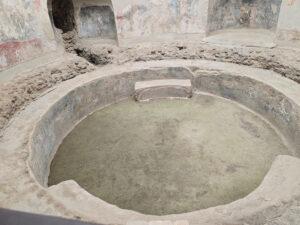 All of us have seen civilizations destroyed. Americans, for example, don’t have to dig hard within their memories to recall the aftermath of Hurricane Katrina in 2005, the superstorm that damaged New Orleans’ levy system so badly that eighty percent of the city was flooded with helpless inhabitants trapped on the roofs of their homes or forced to seek shelter in the Superdome where thousands of people had little to no sanitation or food relief much less air conditioning. 1836 fatalities were attributed to the storm.
All of us have seen civilizations destroyed. Americans, for example, don’t have to dig hard within their memories to recall the aftermath of Hurricane Katrina in 2005, the superstorm that damaged New Orleans’ levy system so badly that eighty percent of the city was flooded with helpless inhabitants trapped on the roofs of their homes or forced to seek shelter in the Superdome where thousands of people had little to no sanitation or food relief much less air conditioning. 1836 fatalities were attributed to the storm.
Or how about the tornadoes in Oklahoma (in Moore, 2013) or Tennessee (2023) in recent years covered in full by video images of the aftermath and accompanied by eyewitness testimonials of survivors from the harrowing moments. Tornadoes pack the highest concentrated winds on earth. Nothing is spared from their wrath.
Two years ago, of course, was the unbelievable wildfire that destroyed the seaside resort town of Lahaina in Maui, Hawaii, which struck the residents completely by surprise, fanned by hurricane strength winds and incredibly dry conditions. The uncontrolled fire basically burned itself out before it was finished, with well over a hundred residents having lost their lives within the span of a couple days.
Or how about the Los Angeles area wildfires earlier this year that leveled dozens of square miles of “civilization” originally thought to be wholly indestructible?
Everyone is shocked when these types of things happen. But all of them pale in comparison to what ensued to the ancient city of Pompeii, where no one lived to tell the tale.
Visiting Pompeii in our times was fascinating to say the least. Though we know the volcanic eruption and reverberations occurred over the course of a couple days, the citizens of the city were overwhelmed so quickly that they had little or no opportunity to escape, the result being they died basically doing whatever they were doing at the time – and the buildings themselves were covered and preserved in such a manner that it is fairly easy to discern how the people lived thousands of years ago.
Unlike Rome, which was built and shaped over the course of centuries and Millenia, Pompeii stayed the same as it had been in its last days. It’s not difficult to reconstruct a “day in the life” depiction of how the Italians in the first century lived from day to day there. There certainly might be other places equally as vivid, but Pompeii presents a lesson that few others can match in terms of graphic – and accurate – renderings of real once-living, breathing people.
It’s almost like reassembling a fossilized skeleton for a museum.

 The reconstructed forms of the dead from Pompeii are especially striking – and a bit creepy. The bones and flesh are long gone, but their forms are here for eternity, as were their death poses. Again, sobering. Sculptures and Fresco paintings have also navigated time in the excavated city. Someone had to create those works. We saw where the people cooked, slept, how their sewage system operated, their places of entertainment, etc. Amazing.
The reconstructed forms of the dead from Pompeii are especially striking – and a bit creepy. The bones and flesh are long gone, but their forms are here for eternity, as were their death poses. Again, sobering. Sculptures and Fresco paintings have also navigated time in the excavated city. Someone had to create those works. We saw where the people cooked, slept, how their sewage system operated, their places of entertainment, etc. Amazing.
What lessons could today’s American leaders take from reviewing Pompeii’s tragic story? First and foremost, there’s only so much that can be done to counteract the immense forces of nature. Here’s thinking that most of the region’s inhabitants would’ve been warned with enough time to escape if such a phenomenon were to occur today, but there still would’ve been casualties. Mt. Vesuvius itself is an active volcano which will, as scientists predict, erupt again. It’s done so a number of times since Pompeii was flattened.
Therefore, it’s a matter of when, not if.
“Climate change” advocates would have you believe that mankind (can you even call it that any longer?) is answerable for the contemporary deterioration of the earth and atmosphere. A trip to Pompeii would demonstrate to any visitor that Mother Nature (and God) are in control and can do far greater and quicker damage than any fleet of carbon-belching cars, trucks, airplanes and cruise ships could ever do. What today’s American leaders can garner is perspective – we can do what we can to plan for and then recapture when these things strike.
But the rest is up to the human spirit to overcome.
 Next, federal response helps, but it’s basically reserved for the locals to “recover” from anomalies. The citizens of Pompeii obviously didn’t get over what happened. But surrounding cities and towns went on, to the extent where Pompeii was eventually forgotten (hence its “re-discovery” half a Millenia ago).
Next, federal response helps, but it’s basically reserved for the locals to “recover” from anomalies. The citizens of Pompeii obviously didn’t get over what happened. But surrounding cities and towns went on, to the extent where Pompeii was eventually forgotten (hence its “re-discovery” half a Millenia ago).
Lesson — the federal government can’t do everything – and it shouldn’t attempt to supplant the efforts of the local inhabitants to move on from tragedy. The natural environment recuperates from catastrophic happenings – things grow back; birds and animals return, the region regenerates. No one told you to build a house on a brush covered slope. Insurance, anyone?
Not to mention having local authorities who blundered their responsibilities. See LA fires.
It’s not the government’s fault when these things take place, nor should we act like it was. Nor should government provide guarantees that nothing bad will ever happen. Mt. Vesuvius, in its own way, decides when it will erupt again, as do the active volcanoes in Hawaii, or earthquake faults around the Pacific Rim, etc.
America’s Founding Fathers said that government exists to protect natural rights, not to ensure that nothing injurious ever transpires by nature or other occurrences. Government is also tasked with protecting citizens from foreign enemies – or invasion, which certainly includes the plagues from illegal immigration.
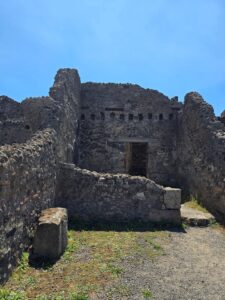
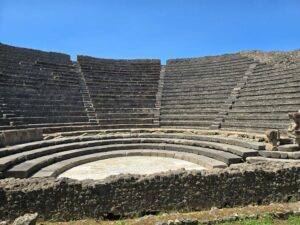 History indicates that several different peoples controlled the region around Pompeii before the Romans, but you can’t help but sense that they lived life pretty freely, hence they developed their own culture, language and local customs. Is there something to be garnered from this? Thousands of years didn’t dismantle the way Pompeii’s inhabitants lived. Government only provided them so much. The rest was up to them.
History indicates that several different peoples controlled the region around Pompeii before the Romans, but you can’t help but sense that they lived life pretty freely, hence they developed their own culture, language and local customs. Is there something to be garnered from this? Thousands of years didn’t dismantle the way Pompeii’s inhabitants lived. Government only provided them so much. The rest was up to them.
Today’s American leaders can also remember that science and technology exist to serve man – and that the planet itself won’t slowly deteriorate to kill everyone off. Pompeii’s end was quick as are the majority of natural occurrences. The fallacy of “climate change” must be vigorously challenged. Have we learned?
The last take from Pompeii? Civilizations can and do take time to develop as do governmental systems and philosophies. But it all can be snuffed out in a (virtual) instant. Today’s political class would do well to remember that only so much can be done now to fix the mess that generations of bad governors have inflicted on us citizens in just the last half century or so.
Pompeii shows it can all be gone in a relative instant; but it will take a long time to correct the man-made problems of our day. Can they keep things in perspective? A visit to Pompeii could help.

